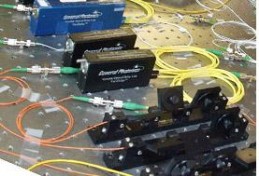High-speed ‘Photonic neuron’ devices blend fiber-optic signal processing and neuroscience
July 20, 2011

The Photonic Neuron project uses fiber-optic devices that make ultrafast calculations with photons of light instead of the electrons used by computer circuits (credit: Frank Wojciechowski)
Researchers at Princeton University in collaboration with Lockheed Martin are developing a “photonic neuron,” a fiber-optic device based partly on neural processing in the human brain.
The project, which started in 2008, seeks to overcome the inherent speed constraints of electrical circuits, which are ultimately limited by the time it takes electricity to flow through wires. Instead of wires, the team is using clear fiber-optic cables, through which information travels at nearly the speed of light.
In coming up with the project, the researchers noticed that while the mathematical equations used to model neural and fiber-optic networks used different variables, they were very similar in their overall formulation.
“We are transposing learning, inhibition, and other behaviors typical of neural processing onto fiber-optic circuits,” said David Rosenbluth, a neuroscientist and principal engineer at Lockheed Martin’s Advance Technology Laboratory. “But I don’t think of it as trying to reproduce something in the brain. It’s a hybrid between the analog computing done in the brain and the purely digital systems used by most computers.”
If the project is successful, the new technology could allow for computer circuits that are capable of making nearly instantaneous calculations in life-or-death situations, such as locating a terrorist from a radio signal or deciding whether to eject a fighter pilot from a jet. It might also allow speedy processing of huge amounts of data, such as the video signals that currently guide the movements of robotic cars or scans of genetic data for clues to fighting diseases.